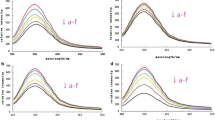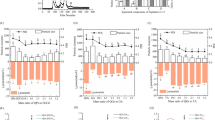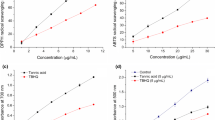Abstract
Senna (Cassia angustifolia) is widely used in Indian folk medicine for the prevention of various disorders. Herein, we have demonstrated that water extracted arabinogalactan protein (AGP) rich fraction possesses strong antioxidative activity. The AGP rich fraction was analyzed using chemical, chromatographic, and spectroscopic methods. Effect of water extracted polymers on bovine serum albumin spectrum was determined using excitation wavelength of 282 nm. The antioxidant capacity of this fraction was studied by ferric reducing antioxidant power (FRAP) and DPPH radical assays. This polymeric fraction, ≥88% of which gets precipitated with Yariv reagent, consisted mainly of (1→5)-/(1→3,5)-linked α-arabinosyl, (1→3)-/(1→3,6)-linked-galactosyl residues and terminal arabinofuranosyl residues. Its in vitro antioxidant capacity is comparable to that of standard antioxidants. Fluorescence quenching studies furnishes evidence for the interaction of the arabinogalactan protein with bovine serum albumin.
Similar content being viewed by others
References
Finkel T, Holbrook NJ. Oxidants, oxidative stress, and the biology of aging. Nature 408: 239–247 (2000)
Liu Z, Lin H, Ye S, Liu QY, Meng Z, Zhang C, Xia Y, Margoliash E, Rao Z, Liu XJ. Remarkably high activities of testicular cytochrome c in destroying reactive oxygen species and in triggering apoptosis. Biochemistry 103: 8965–8970 (2006)
Mucke L. Alzheimer’s disease. Nature 461: 495–497 (2009)
Lee HB, Yu MR, Yang Y, Jiang Z, Ha H. Reactive oxygen species-regulated signaling pathways in diabetic nephropathy. J. Am. Soc. Nephrol. 14: 241–245 (2003)
Paz-Elizur T, Sevilya Z, Leitner-Dagan Y, Elinger D, Roisman L, Livneh Z. DNA repair of oxidative DNA damage in human carcinogenesis: Potential application for cancer risk assessment and prevention. Cancer Lett. 266: 60–72 (2008)
Schwarz K, Bertelsen G, Nissen LR, Gardner PT, Heinonen MI, Hopia A, Huynh-Ba T, Lambelet P, McPhail D, Skibsted LH, Tijburg L. Investigation of plant extracts for the protection of processed foods against lipid oxidation. Comparison of antioxidant assays based on radical scavenging, lipid oxidation, and analysis of the principal antioxidant compounds. Eur. Food Res. Technol. 212: 319–328 (2001)
Waltenberger B, Avula B, Ganzera M, Khan IA, Stuppner H, Khan SI. Transport of sennosides and sennidines from Cassia angustifolia and Cassia senna across Caco-2 monolayers-an in vitro model for intestinal absorption. Phytomedicine 15: 373–377 (2008)
Yadav JP, Arya V, Yadav S, Panghal M, Kumar S, Dhankhar S. Cassia occidentalis L.: A review on its ethnobotany, phytochemical, and pharmacological profile. Fitoterapia 81: 223–230 (2010)
Berteau O, Mulloy B. Sulfated fucans, fresh perspectives: Structures, functions, and biological functions of sulfated fucans and an overview of enzymes active towards this class of polysaccharides. Glycobiology 13: 29–40 (2003)
Chattopadhyay N, Ghosh T, Sinha S, Chattopadhyay K, Karmakar P, Ray B. Polysaccharides from Turbinaria conoides: Structural features and antioxidant capacity. Food. Chem. 11: 823–829 (2010)
Chattopadhyay N, Nosalova G, Saha S, Bandyopadhyay SS, Fleskova D, Ray B. Structural features and antitussive activity of water extracted polysaccharide from Adhatoda vasica. Carbohyd. Polym. 83: 1970–1974 (2011)
Ghosh T, Chattopadhyay K, Marschall M, Karmakar P, Mandal P, Ray B. Focus on antivirally active sulfated polysaccharides: From structure-activity analysis to clinical evaluation. Glycobiology 19: 2–15 (2009)
Song H, Zhang Q, Zhang Z, Wang J. In vitro antioxidant activity of polysaccharides extracted from Bryopsis plumose. Carbohyd. Polym. 80: 1057–1061 (2010)
Zhang Q, Li N, Zhou G, Lu X, Xu Z, Li Z. In vivo antioxidant activity of polysaccharide fraction from Porphyra haitanesis (Rhodephyta) in aging mice. Pharmacol. Res. 48: 151–155 (2003)
Schultz CR, Johnson KL, Currie G, Bacic A. The classical arabinogalactan protein gene family of Arabidopsis. Cell 12: 1751–1767 (2000)
Dubois M, Gilles KA, Hamilton JK, Rebers PA, Smith F. Colorimetric method for determination of sugars and related substances. Anal. Chem. 28: 350–366 (1956)
Ahmed A, Labavitch JM. A simplified method for accurate determination of cell wall uronide content. J. Food Biochem. 1: 361–365 (1977)
Blakeney AB, Harris P, Henry RJ, Bruce AB. A simple rapid preparation of alditol acetates for monosaccharide analysis. Carbohyd. Res. 113: 291–299 (1983)
York WS, Darvill A, O’Neill M, Stevenson T, Albersheim P. Isolation and characterisation of plant cell walls and cell wall components. Method. Enzymol. 118: 3–40 (1985)
Lowry OH, Rosebrough NJ, Farr AL, Randall RJ. Protein measurement with the Folin phenol reagent. J. Biol. Chem. 193: 265–275 (1951)
Blakeney AB, Stone BA. Methylation of carbohydrates with lithium methylsulphinyl carbanion. Carbohyd. Res. 140: 319–324 (1985)
Ray B. Polysaccharides from Enteromorpha compressa: Isolation, purification, and structural features. Carbohyd. Polym. 66: 408–416 (2006)
Huang D, Ou B, Prior RL. The chemistry behind antioxidant capacity assays. J. Agr. Food Chem. 53: 1841–1856 (2005)
Benzie IFF, Strain JJ. The ferric reducing ability of plasma (FRAP) as a measure of “antioxidant power”: The FRAP assay. Anal Biochem. 239: 70–76 (1996)
Kacurakova M, Capek P, Sasinkova V, Wellner N, Ebringerova A. FT-IR study of plant cell wall model compounds: Pectic polysaccharides and hemicelluloses. Carbohyd. Polym. 43: 195–203 (2000)
Capek P, Matulová M, Navarini L, Suggi-Liverani F. Structural features of an arabinogalactan-protein isolated from instant coffee powder of Coffea arabica beans. Carbohyd. Polym. 80: 180–185 (2010)
Frankel EN, Meyer AS. The problems of using one-dimensional methods to evaluate multifunctional food and biological antioxidants. J. Sci. Food Agr. 80: 1925–1941 (2000)
Moon JK, Shibamoto T. Antioxidant assays for plant and food components. J. Agr. Food Chem. 57: 1655–1666 (2009)
Yuan XP, Wang J, Yao HY, Chen F. Free radical scavenging capacity and inhibitory activity on rat erythrocyte hemolysis of feruloyl oligosaccharides from wheat bran insoluble dietary fiber. LWT-Food Sci. Technol. 38: 877–883 (2005)
Ou SY, Jackson GM, Jiao X, Chen J, Wu JZ, Huang XS. Protection against oxidative stress in diabetic rats by wheat bran feruloyl oligosaccharides. J. Agr. Food Chem. 55: 3191–3195 (2007)
Wang J, Zhang Q, Zhang Z, Song H, Li P. Potential antioxidant and anticoagulant capacity of low molecular weight fucoidan fractions extracted from Laminaria japonica. Int. J. Biol. Macromol. 46: 6–12 (2010)
Wang J, Zhang J, Wang X, Zhao B, Wu Y, Yao J. A comparison study on microwave-assisted extraction of Artemisia sphaerocephala polysaccharides with conventional method: Molecule structure and antioxidant activities evaluation. Int. J. Biol. Macromol. 45: 483–492 (2009)
Zhang Q, Li N, Liu X, Zhao Z, Li Z, Xu Z. The structure of a sulfated galactan from Porphyra haitanensis and its in vivo antioxidant activity. Carbohyd. Res. 339: 105–111 (2004)
Ruperez P, Ahrazem O, Leal A. Potential antioxidant capacity of sulphated polysaccharides from the edible marine brown seaweed Fucus vesiculosus. J. Agr. Food Chem. 50: 840–845 (2002)
Qi H, Zhang Q, Zhao T, Hu R, Zhang K, Li Z. In vitro antioxidant activity of acetylated and benzoylated derivatives of polysaccharide extracted from Ulva pertusa (Chlorophyta). Bioorg. Med. Chem. 16: 2441–2445 (2006)
Wang J, Zhang J, Zhao B, Wang X, Wu Y, Yao J. A comparison study on microwave-assisted extraction of Potentilla anserina L. polysaccharides with conventional method: Molecule weight and antioxidant activities evaluation. Carbohyd. Polym. 80: 84–93 (2010)
Zhang Z, Wang F, Wang X, Liu X, Hou Y, Zhang Q. Extraction of the polysaccharides from five algae and their potential antioxidant activity in vitro. Carbohyd. Polym. 82: 118–121 (2010)
Je J, Park P, Kim E, Park J, Yoon H, Kim K, Ahn C. Antioxidant activity of enzymatic extracts from the brown seaweed Undaria pinnatifida by electron spin resonance spectroscopy. LWT-Food Sci. Technol. 42: 874–878 (2009)
Rice-Evans CA, Miller NJ, Paganga G. Structure-antioxidant activity relationships of flavonoids and phenolic acids. Free Radical Bio. Med. 20: 933–956 (1996)
Peters T. Serum albumin. Adv. Protein Chem. 37: 161–245 (1985)
Author information
Authors and Affiliations
Corresponding author
Rights and permissions
About this article
Cite this article
Sinha, S., Bandyopadhyay, S.S., Ghosh, D. et al. Structural characteristics, fluorescence quenching, and antioxidant activity of the arabinogalactan protein-rich fraction from senna (Cassia angustifolia) leaves. Food Sci Biotechnol 20, 1005–1011 (2011). https://doi.org/10.1007/s10068-011-0138-y
Received:
Revised:
Accepted:
Published:
Issue Date:
DOI: https://doi.org/10.1007/s10068-011-0138-y




